The Paradise fish is one of the very first tropical fish that were brought to Europe in the 1800s and is responsible for bringing many hobbyists into the fish keeping world. If you’re looking for a small, attractive fish that’s exceptionally hardy and easy to keep, then one of these active little beauties could be just what you’re looking for.
Read this guide to find out more about Paradise fish and learn how to care for them.

Origins
The Paradise fish, scientific name Macropodus opercularis, was first discovered in 1758 by Linnaeus. The fish were brought to Europe in the 1800s and became the first tropical fish to be kept as ornamental pets, joining goldfish as founders of the aquarium hobby.
The species is widely distributed across Southeast Asia. In China, Paradise fish are found in the Yangtze River basin to the Pearl River basin, on Hainan Island, and in Hong Kong. The species also exists in some parts of Vietnam, Laos, Taiwan, Japan, Cambodia, Malaysia, Korea, and the Ryuku Islands. Outside of its natural range, the Paradise fish is now seen in Madagascar and even in the United States.
Paradise fish are also known by a few other common names, including:
- Paradise gourami
- Blue Paradise Fish
- Paradisefish
- Red and Blue Paradise Fish
- Blue Paradise gourami
The fish are relatively easy to breed commercially, so the fish that you buy at pet stores are not wild-caught. Although some areas of the species’ wild habitat are suffering from destruction and water pollution, the Paradise fish is regarded as being of least concern on the IUCN Red List.
There are nine species in the Macropodus genus, of which the Paradise fish is the oldest, and six of those species have been recognized recently.
Natural habitat
Paradise fish are found at all kinds of lowland habitats. The fish are found in the backwaters of rivers, in rice paddies, streams, ponds, and marshes, preferring to live in very still or slow-moving waters. Like all members of the gourami family, Blue Paradise fish are labyrinth breathers or Anabantoids. These fish have a special respiratory organ that allows them to breathe atmospheric oxygen by gulping air at the surface of the water, and that ability enables the fish to survive in stagnant water that contains very little oxygen or are polluted.
Paradise fish primarily feed on small fish, fry, and planktonic invertebrate creatures, as well as plant matter. These fascinating fish have even been observed leaping out of the water to grab prey that’s flying just above the water surface.
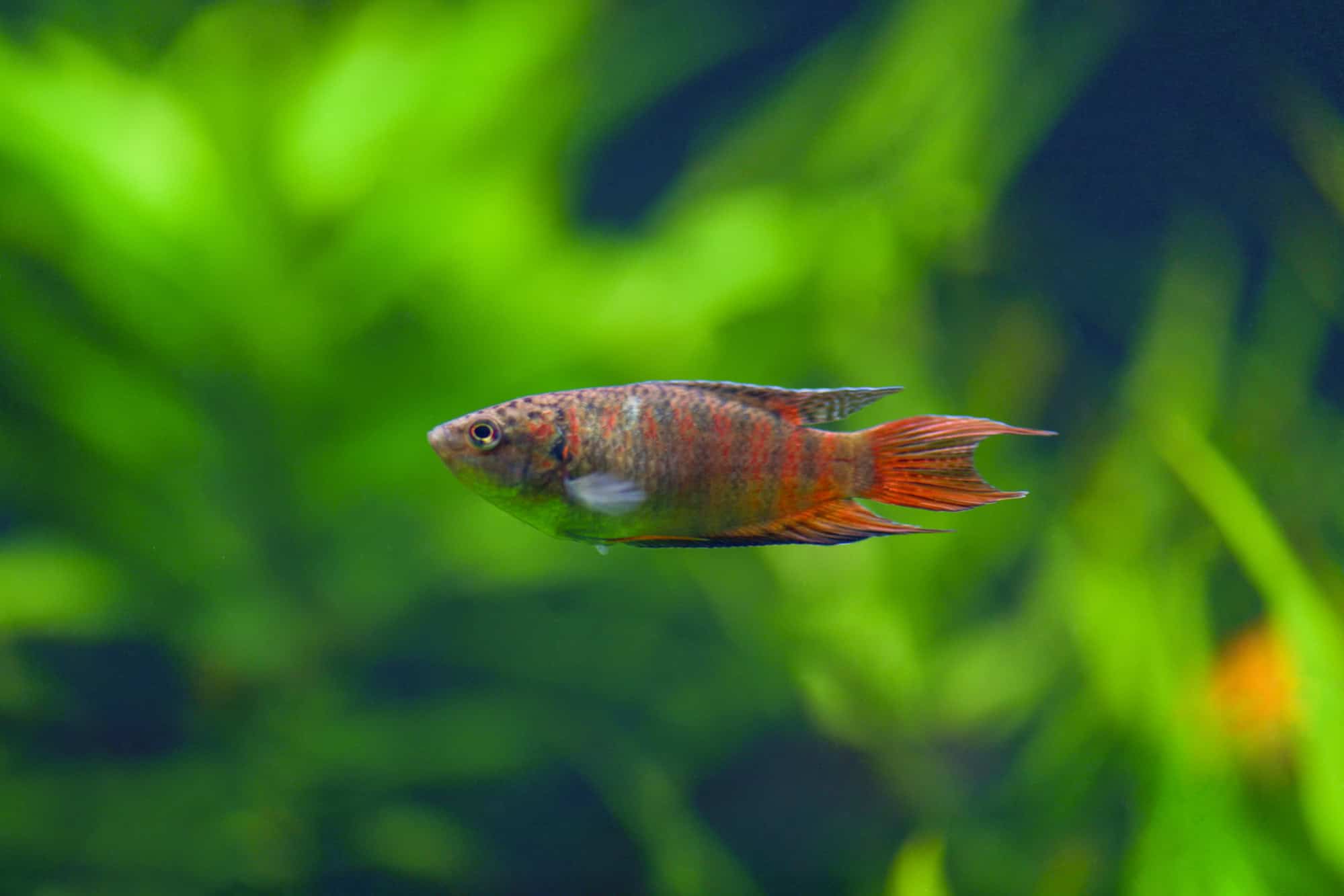
Appearance
The Paradise gourami has a long body and pointed fins. In males, the tail fin is forked and grows to be up to an inch or two long, finishing in serrated filaments. These beautiful little fish are colored in a mixture of blues and reds with white and black markings on a blue background. The vertical red body striping extends to the fins. You can also find albino and black color morphs of these pretty fishes. In particular, the albino variety has bright scarlet blotches and vertical stripes.
In the wild, males of this fish species grow to around four inches in length, with the females being a little smaller at just over three inches long. The average lifespan of these fish is around six years, although they can live for up to eight years if well-cared for.
There are several color forms, including bd albino. Albino varieties can have a very attractive appearance, being white accented with brilliant red blotches and vertical stripes.
Paradise Fish Care Guide
Now that you know more about these gorgeous fish species, you’ll need to know how to look after them. In this part of our article, we tell you everything you need to know about caring for the Paradise gourami, and more.
Tank size
One Paradise fish would be fine in a small tank of just five gallons, but these are social fish that are happiest when kept in a small school. So, you really want a 20-gallon tank for a single fish or a 30-gallon, long tank for a pair or a small group.
Macropodus opercularis swim in all areas of the water column, but these labyrinth breathers do need access to the surface so that they can take gulps of air. For that reason, a tank that is longer than it is deep is the best design to choose. A long tank also has a large surface area that ensures plenty of gaseous exchange for better water oxygenation.
As previously mentioned, Paradise fish are accomplished jumpers, so the aquarium must have a cover slide or a tightly fitting lid.
Water parameters
Paradise fish are pretty hardy creatures and can adapt themselves to most tank and water conditions, including a wide range of water temperatures. So, if your home is warm and the tank is in a room where the temperature remains stable, and with no massive fluctuations, you could keep these fish in an unheated tank.
The aquarium should have an efficient filter and be well-aerated, but the fish prefer slow-moving water, so you should adjust the pump flow accordingly.
Paradise fish can tolerate a wide temperature range from 61° to 79.0° Fahrenheit. Water pH should be between 5.8 and 8.0, with a hardness range of between 5 and 50 dGH.
Tank decoration
These fish prefer a well-planted aquarium that has plenty of dense plant cover in which to hide. Floating plants are also a good idea, as long as they don’t clog the water surface completely. Male Paradise fish will build a bubble nest, and floating plants encourage this natural behavior.
In nature, Paradise fish are territorial, and it’s important that you set up your tank in such a way that enables the fish to indulge in that instinctual behavior. So, you’ll need to include plenty of driftwood and rocks interspersed with plants so that the dominant fish can establish their own patch, while the quieter fish and females have areas where they can feel safe.
We recommend that you use a dark substrate that will show off the fishes’ colors to the best effect. Lighting in the tank should be at normal levels of brightness.
Diet and nutrition
The so-called Fish of Paradise are omnivorous, but they do prefer a diet that consists of primarily meaty foods. As with all fish species, giving your pets a balanced, nutritious diet is essential if you want your fish to stay healthy and develop those lovely colors that make the Paradise fish such a pleasure to own.
So, we recommend that you feed your fish a daily diet of flakes or pellets, supplemented with blanched peas and zucchini and some frozen or live bloodworms, white worms, brine shrimp, and mosquito larvae. You should take care not to overfeed your fish, as that can cause health problems. Two small feeds per day are more than enough to keep your fish happy, offering them just enough to keep them busy for a minute or two.
Tankmates
Paradise fish can be included in a community tank, provided that you pick the right tankmates for them. Because of the species’ territorial nature, males can be aggressive and belligerent and should be kept in species-specific groups of both genders. You can keep groups of young Paradise fishes, although they may become aggressive as they mature, and they are not averse to eating small fish and crustaceans.
The best way to maintain harmony among the fish is to provide them with a very large tank and plenty of planting and decoration that allows the fish plenty of space. Males will fight if they are kept in close quarters, but female Paradise fish will live happily in a group.
Suitable tankmates are larger, semi-aggressive species that won’t tolerate being pushed around by the male Paradise fish. However, if the other community members are too aggressive, the Paradise fish will become stressed and miserable. There is an urban myth that a male Paradise fish can live with a betta, but that’s not true, and the two fish will almost certainly fight. Some types of larger, robust cichlids, characins, or cyprinids can make suitable tankmates for the Paradise fish, and medium to large gouramis are also usually okay. You could try Loricariid catfish and larger species of loaches too.
As a general rule, it’s best to avoid fish that are slow swimmers or that have floating finnage, as these types make a target for an aggressive male Paradise fish.
Breeding
Paradise fish are relatively easy to breed in captivity, provided that you set up a separate spawning tank. As is typical of most labyrinth breathers, the male fish builds a bubble nest, usually underneath a flat-leaf plant or rocky overhang, which it then defends against all-comers.
You’ll need to condition your breeding pair before introducing them to the spawning tank by offering small amounts of frozen and live foods several times each day. The female fish begin to swell with eggs and become plump, indicating that they are ready for breeding. Any females that are not ready to breed should be kept separated from the males, as males are very belligerent and may attack or even kill those females who are not ready to spawn.
Spawning tank
The spawning tank should be at least 20 gallons in size and set up with a low water level of between six to eight inches. To induce spawning, increase the water temperature to between 80° and 84° Fahrenheit. Keep the water flow in the tank to a minimum.
Place a few clumps of lush plants in the tank and include floating plants to encourage the male to build a bubble nest. As some of the females may be bullied by the male, the plants are important to provide the female fish with hiding places.
Spawning
When the bubble nest is complete, the male will herd the female fish underneath the nest. He will coil himself around her, and the couple will spawn. After spawning, both fish will lay on the bottom of the tank while they recover. Depending on how many eggs the female was carrying, the process may be repeated several times. A typical spawn will produce around 500 eggs.
Most of the eggs float up to the bubble next. Any that fail to float or sink back down again will be collected by the male who will carry them in his mouth up to the nest. He will remain by the nest to guard it until the eggs hatch. At this point, you must remove the female, as the male will become super-feisty and may even kill his mate if she comes too close to the precious eggs.
Eggs and fry
The eggs typically hatch after around 30 to 50 hours, depending on the water temperature. If the water temperature is cooler, then the fry may not emerge for 96 hours. Once hatched, the fry is free-swimming, and the nest collapses. You can feed the fry with a liquid fry food or infusoria until they grow big enough to take live baby brine shrimp.
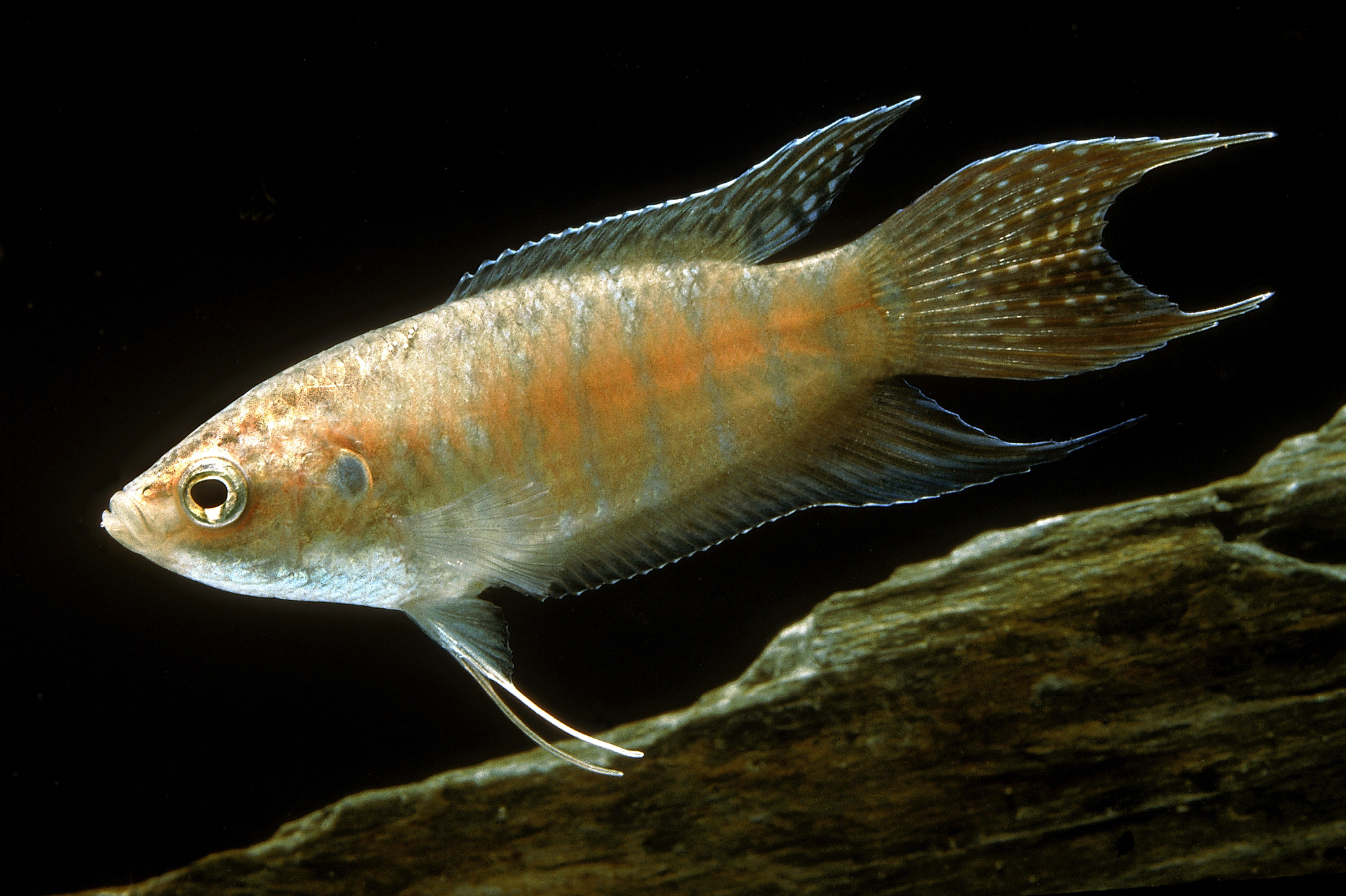
Health and disease
Paradise fish are generally very hardy creatures and are not especially susceptible to diseases. However, if they are not provided with clean water and a nutritious, balanced diet, the species can suffer from bacterial infections, Hole-in-the-Head disease, and constipation.
You can prevent the introduction of parasites and bacteria into your main tank by quarantining all new fish and invertebrates in a hospital tank for at least 14 days before adding them to your display aquarium. All plants, decorations, and any new substrate should be thoroughly washed before use. Also, if you decide to give live food to your fish, make sure that you are buying it from a reputable supplier or grow your own.
Prevent outbreaks of disease by keeping your tank clean, carrying out weekly 25% water changes, and making sure that the fish are happy and not stressed.
Monitor your fish closely and look for signs of disease. Any fish that appear lethargic are off their food or have any obvious external signs of illness, such as white spots on the skin, ulcers, wounds, etc. should be removed from the tank and placed in isolation for treatment. Early treatment is the key to successfully treating outbreaks of diseases, so be vigilant.
Availability
Paradise fish are readily available from good fish stores and online. All specimens are likely to be tank-bred, and you can pick them up for a few dollars per fish.
In summary
Paradise fish are often overlooked, but these attractive, interesting fish can make a great addition to a community tank that contains larger, semi-aggressive species that will not be intimidated by the feisty male Blue gouramis.
These fish are extremely hardy and tolerant of a wide range of water conditions, making them a good choice for a beginner who is happy to keep a large, species-specific tank.












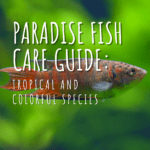


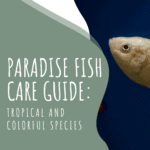
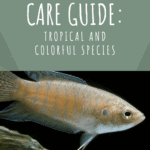






I have a female paradise gourami fish I’m getting a male paradise gourami fish they will be mr. And mrs (lightblue) I will add 2 dwarf algea eaters and 1 single male plale bodied purple finned cambodia veiltail bettafish.
Most algae eater species need to be kept in schools so keep that in mind! The betta fish is also incompatible with the rest of the stocking.
Ive decided to put a male Empire gudgeon fish in with may Pair of blue paradise gourami fish
Good luck!